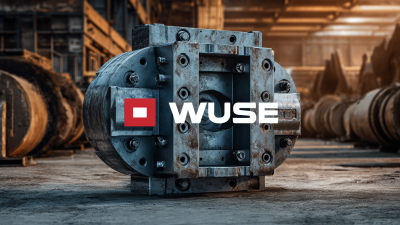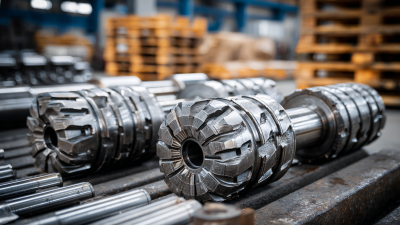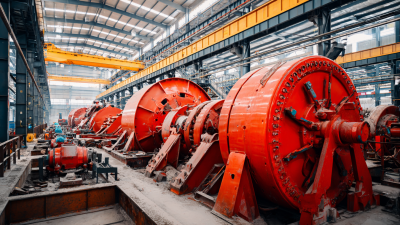
-
Home
-
About Us
-
Products
-
News
-
Blog
-
Contact Us
Leave Your Message

In the world of mining operations, the efficiency and effectiveness of crushing equipment play a pivotal role in optimizing productivity. Among the various types of crushers, jaw crushers are especially critical due to their ability to handle large volumes of rock and ore. According to a recent report by Market Research Future, the global jaw crusher market is expected to reach approximately USD 1.7 billion by 2025, growing at a CAGR of 6.6%. This growth underscores the importance of understanding the individual components of these machines, particularly "Jaw Crusher Parts", which directly influence operational performance and maintenance costs.

By focusing on the functionalities and material specifications of jaw crusher parts such as the jaw plates, toggles, and bearings, operators can ensure enhanced durability, reduced downtime, and optimized crushing efficiency, thereby improving overall productivity in mining operations.
The operational efficiency of mining operations is significantly influenced by the performance of jaw crusher parts. As advancements continue in the mining sector, companies are developing new jaw crushers that integrate cutting-edge technology to enhance reliability and optimize crushing processes. For instance, newly upgraded models are designed to ensure higher performance standards, which directly contributes to improved throughput and reduced operational costs. This evolution demonstrates that investing in high-quality crusher components is paramount for maximizing efficiency in mining activities.
Tips: Regular maintenance of jaw crusher parts is essential. Ensure that inspection and replacement of wear parts are included in your routine schedule to reduce downtime. Additionally, always consider using OEM parts to maintain the integrity of your equipment and avoid risks associated with counterfeit products.
Moreover, the introduction of advanced materials and designs in wear parts offers unprecedented performance, addressing the demands of modern mining operations. When integrating these innovative components, companies can significantly enhance the durability and effectiveness of their crushing systems, ultimately leading to better resource recovery and operational productivity.
| Part Name | Material | Function | Impact on Efficiency (%) | Maintenance Frequency (Months) |
|---|---|---|---|---|
| Jaw Plate | High Carbon Steel | Crushing Material | 25% | 6 |
| Toggle Plate | Alloy Steel | Support Jaw Movement | 15% | 12 |
| Bearings | Bronze | Reduce Friction | 20% | 18 |
| Flywheel | Cast Iron | Energy Storage | 10% | 24 |
| Crusher Frame | Welded Steel | Structural Support | 5% | 36 |
 Jaw crushers play a critical role in mining operations, primarily due to their robust design and ability to handle large volumes of material. Key components of jaw crushers,
including the jaw plates, toggle plates, and the frame itself, significantly contribute to their functionality. The jaw plates, which come in various materials
and designs, are essential for crushing ores and rocks. They create a powerful crushing action, with the toggle plates transmitting force and ensuring that the jaw plates maintain optimal contact during operation,
leading to efficient material handling and minimized downtime.
Jaw crushers play a critical role in mining operations, primarily due to their robust design and ability to handle large volumes of material. Key components of jaw crushers,
including the jaw plates, toggle plates, and the frame itself, significantly contribute to their functionality. The jaw plates, which come in various materials
and designs, are essential for crushing ores and rocks. They create a powerful crushing action, with the toggle plates transmitting force and ensuring that the jaw plates maintain optimal contact during operation,
leading to efficient material handling and minimized downtime.
Durability is another crucial aspect of jaw crusher components, which directly impacts mining productivity and cost efficiency. High-quality materials
such as manganese steel are commonly used for jaw plates due to their excellent wear resistance. Additionally, regular maintenance and timely replacement of worn-out parts can enhance the longevity of the crusher.
Factors such as the type of material being processed and operational conditions also influence the lifespan of these components. By understanding the intricate functionality and durability of jaw crusher parts,
mining operators can make informed decisions to optimize their operations and reduce unnecessary costs.
Jaw crushers are pivotal in mining operations, serving as primary crushers that break down large rocks and ore into manageable pieces. However, understanding the statistics on jaw crusher failure rates is crucial for maintaining operational efficiency and maximizing equipment lifespan. According to a report from the Mining Equipment Manufacturers Association (MEMA), the average failure rate of jaw crushers is around 20-25% per year, attributed primarily to inadequate maintenance practices and operational stress. Regular monitoring and timely replacement of wear parts can significantly mitigate these risks.
To ensure the longevity of jaw crushers, operators should follow comprehensive maintenance schedules that include routine inspections and timely lubrication. Statistically, proper maintenance can extend the service life of jaw crusher components by up to 40%, according to research from the International Journal of Mining Science and Technology. Additionally, bearing failures are often responsible for nearly 60% of jaw crusher downtimes. By implementing predictive maintenance techniques and leveraging condition monitoring technologies, mining companies can reduce unexpected failures and enhance productivity. Adopting these practices not only ensures equipment reliability but also contributes to overall operational efficiency in mining processes.
This chart illustrates the failure rates associated with various maintenance activities for jaw crushers. Regular maintenance is crucial to reduce failure rates and prolong the life of the equipment.
In the realm of mining operations, the selection of jaw crusher components plays a pivotal role in optimizing throughput and ensuring operational efficiency. Choosing the right size and configuration of jaw crusher parts significantly impacts not only the equipment's performance but also the overall productivity of the mining process. Proper component selection allows for an effective balance between power consumption and material processing capabilities, leading to enhanced output and reduced downtime.

Recent insights emphasize the necessity of efficient crushing and screening, highlighting that a well-optimized jaw crusher is crucial for maintaining the cost-effectiveness of quarry operations. Innovations in design, such as compact yet robust models, can enhance flexibility and adaptability in various mining environments. Emphasizing the importance of tailored strategies in component selection ensures that jaw crushers operate at their best, ultimately contributing to a high-quality end product while minimizing operational costs.
Investing in quality parts for jaw crushers in mining operations can yield significant long-term benefits, especially when contrasted with the costs of frequent replacements. According to a report by the United Nations, maintenance and operational efficiency in mining equipment are directly linked to the quality of parts used. High-quality components can enhance the lifespan of machinery by up to 40%, resulting in lower operational downtimes. This is particularly crucial in the mining sector, where equipment failure can lead to substantial production losses and increased maintenance costs, which can exceed millions of dollars annually.
Additionally, the economic implications of investing in quality parts extend beyond immediate cost savings. A comprehensive analysis conducted by the National Mining Association indicated that improved durability and performance of equipment, driven by superior parts, can lead to a 25% increase in productivity. This not only boosts the profitability of mining operations but also creates a ripple effect by generating more employment opportunities across the supply chain. As the manufacturing sector continues to recover from the adverse effects of globalization, prioritizing investment in quality mining equipment can catalyze job creation, particularly for underrepresented groups disproportionately impacted by job losses in this field.





